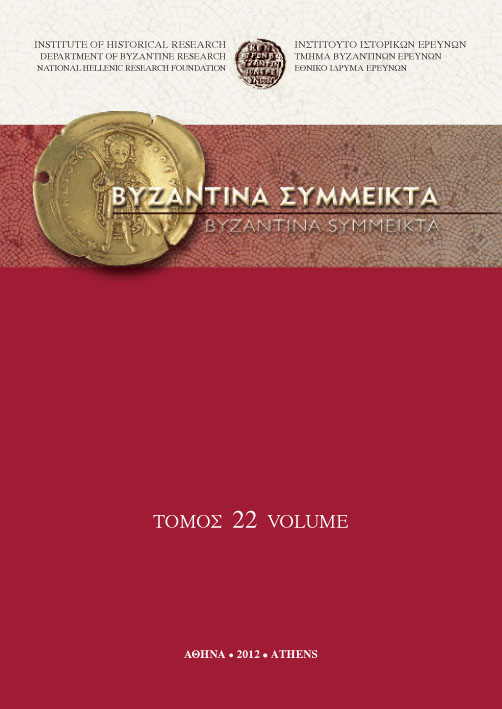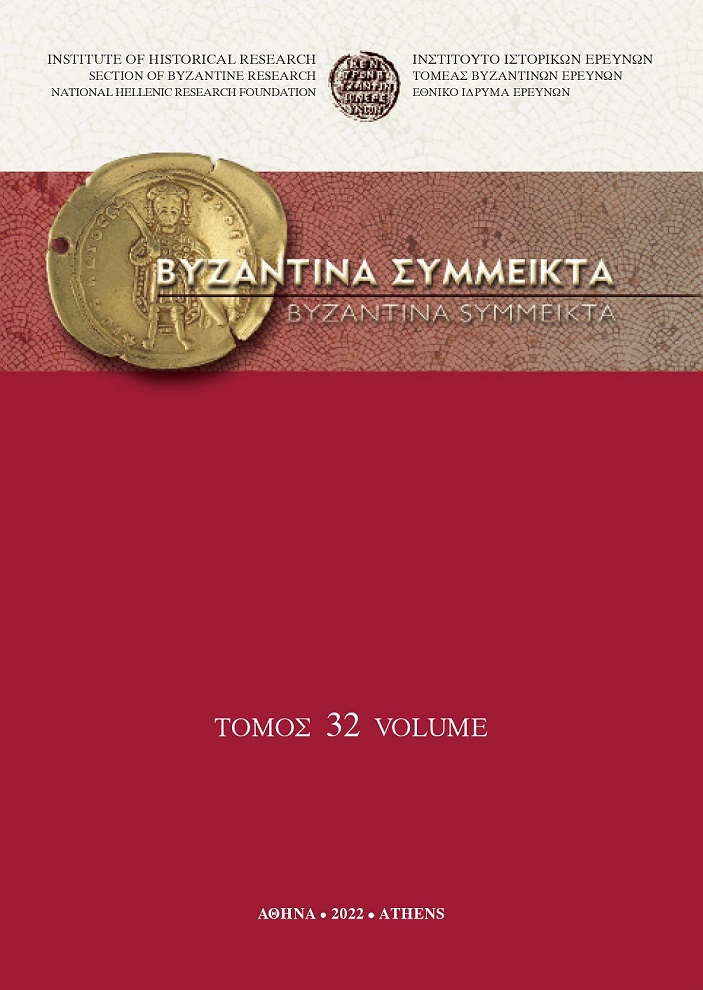"τοῦ βάρβαρον κλύδωνα βαρβάρων στόλῳ μετατρέποντος…" Μία πρόταση ερμηνείας της ψηφιδωτής επιγραφής των κτιστών από τον ναό του Αγίου Δημητρίου

Περίληψη
The study presents a different interpretation of the inscription that accompanies the well known mosaic of the donors of St Demetrius’ church in Thessaloniki:
“Κτίστας θεωρεῖς τοῦ πανενδόξου δόμου ἐκεῖθεν ἔνθεν μάρτυρος Δημητρίου τοῦ βάρβαρον κλύδωνα βαρβάρων στόλῳ μετατρέποντος κ(αὶ) πόλιν λυτρουμένου”.
Until ten years ago the prevailing opinion among researchers was that the fourteenth word should be read as στόλω(ν) rather than στόλῳ, since in their opinion this made the meaning of the inscription clearer: “…St Demetrius drew away the wild storm (βάρβαρον κλύδωνα) caused by the barbarian fleet or even the barbarian flood/crowd of the barbarian fleet”. The inscription is traditionally connected with the attack of the Avaroslavs against Thessaloniki in 614 mentioned in St Demetrius’ Miracles (Περί τῆς κατασκευῆς τῶν πλοίων τῶν Δρουγουβιτῶν, Σαγουδατῶν, Βελεγεζιτῶν καὶ τῶν λοιπῶν).
The transcription (στόλῳ) and the new interpretation (…St Demetrius sent a ferocious storm against the barbarian fleet) proposed by G. Velenis (2003), who also connects the inscription with the attack of 614, are now the most accepted (D. Feissel, W. Hörandner, A. Paul, A. Rhoby), although Ar. Mentzos (2010) and Ch. Bakirtzis (2012) expressed different views based on a different meaning and syntax of the participle μετατρέποντος as well as the meaning of the word “στόλῳ”. According to the first scholar, St. Demetrius always turns away the ferocious storm of the barbarian attacks (βάρβαρον κλύδωνα βαρβάρων) through the defensive preparation (στόλῳ), while according to the latter St. Demetrius turned away the barbarian storm of the barbarians (βάρβαρον κλύδωνα βαρβάρων) through his invisible army (στόλῳ). Both these scholars disconnect the epigram from a specific attack, like that of 614.
In our opinion, however, none of the above interpretations is satisfactory. The meaning of the verb μετατρέπω is indeed “overthrow”, “turn back/away”, and its object is normally in the accusative. The object of the participle μετατρέποντος is the noun κλύδωνα modified by the adjective βάρβαρος. This phrase means not only the “wild storm” but also the “wave of barbarians” or even the “flood of barbarians” that was turned away by St. Demetrius (μετατρέποντος) who used their own fleet (βαρβάρων στόλῳ) against them. Such an interpretation is supported by the narrative of St Demetrius’ Miracles concerning the attack of 614, which says that the patron of the city walked on the sea and troubled the ships of the Slavs, which became entangled and some were overturned. The men who fell into the sea tried to save themselves by grabbing hold of those ships that continued to sail, but these were also overturned, and the men aboard them turned their swords on those who were trying to grasp hold of and clamber on to them, cutting off their arms and killing them (οἱ τῶν ἑτέρων ναύκληροι τῶν πρὸς αὐτοὺς προϊεμένων τὰς χεῖρας μετὰ ξιφῶν ἀπέτεμνον, ἄλλος ἄλλῳ κατὰ τῆς κεφαλῆς τὸ ξίφος ἀπέπεμπεν, ἕτερος δὲ τὸν ἕτερον λόγχῃ ἐτίτρωσκε, καὶ ἕκαστος τὴν ἑαυτοῦ σωτηρίαν πραγματευόμενος τοῦ ἑτέρου ἐχθρὸς ἐγίνετο). And so the barbarians fought amongst themselves and the sea of the Thermaikos Gulf became red with their blood. This was the turning point in the unsuccessful attack against Thessaloniki. The other divine intervention that helped the Thessalonians, according to the Miracles, was a wind that suddenly blew up and dispersed the rest of the barbarians’ ships (ἐναπομείνασας ναυκέλλας) which were forced to sail to the east and to the west of the city without being able to attack.
In conclusion, the inscription, which refers to the mainly naval invasion of 614, as is implied by the use of the words κλύδωνα and στόλῳ, describes the intervention of St Demetrius, who turned back the “barbarian wave”, that is the barbarians, using their own fleet and causing them to kill one another.
Λεπτομέρειες άρθρου
- Πώς να δημιουργήσετε Αναφορές
-
ΓΚΟΥΤΖΙΟΥΚΩΣΤΑΣ Α. Ε. (2014). "τοῦ βάρβαρον κλύδωνα βαρβάρων στόλῳ μετατρέποντος…" Μία πρόταση ερμηνείας της ψηφιδωτής επιγραφής των κτιστών από τον ναό του Αγίου Δημητρίου. Βυζαντινά Σύμμεικτα, 24(1), 11–28. https://doi.org/10.12681/byzsym.1123
- Τεύχος
- ΒΥΖΑΝΤΙΝΑ ΣΥΜΜΕΙΚΤΑ 24
- Ενότητα
- Άρθρα

Αυτή η εργασία είναι αδειοδοτημένη υπό το CC Αναφορά Δημιουργού – Μη Εμπορική Χρήση – Παρόμοια Διανομή 4.0.
Οι συγγραφείς των άρθρων που δημοσιεύονται στα ΒΥΖΑΝΤΙΝΑ ΣΥΜΜΕΙΚΤΑ διατηρούν τα δικαιώματα πνευματικής ιδιοκτησίας επί των άρθρων τους, δίνοντας στο περιοδικό το δικαίωμα της πρώτης δημοσίευσης. Άρθρα που δημοσιεύονται στα ΒΥΖΑΝΤΙΝΑ ΣΥΜΜΕΙΚΤΑ μπορούν να χρησιμοποιούνται ελεύθερα, χωρίς δικαίωμα τροποποίησης (δημιουργία παράγωγου έργου) με αναφορά στο συγγραφέα και στην πρώτη δημοσίευση για μη κερδοσκοπικούς σκοπούς(άδεια Creative Commons 4.0). To Εθνικό Ίδρυμα Ερευνών διατηρεί το δικαίωμα να δημοσιεύει, να αναπαραγάγει, να παρουσιάζει στο κοινό, να διανέμει και χρησιμοποιεί άρθρα που δημοσιεύονται στα ΒΥΖΑΝΤΙΝΑ ΣΥΜΜΕΙΚΤΑ σε οποιοδήποτε μέσο και μορφή είτε μεμονωμένα είτε ως μέρη συλλογικών έργων, για όλο το χρόνο διάρκειας προστασίας της πνευματικής ιδιοκτησίας και για όλες τις χώρες του κόσμου. Αυτό περιλαμβάνει ενδεικτικά και όχι αποκλειστικά, το δικαίωμα δημοσίευσης των άρθρων σε τεύχη του περιοδικού ΒΥΖΑΝΤΙΝΑ ΣΥΜΜΕΙΚΤΑ, αναπαραγωγής και διανομής μεμονωμένων αντιγράφων των άρθρων, αναπαραγωγής ολόκληρων των άρθρων σε άλλη έκδοση του ΕΙΕ, και αναπαραγωγής και διανομής των άρθρων ή περίληψης αυτών με χρήση πληροφορικού συστήματος αποθετηρίου.





